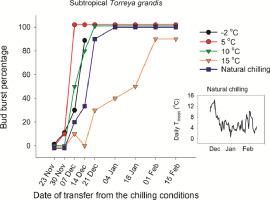Agricultural and Forest Meteorology ( IF 5.6 ) Pub Date : 2020-12-31 , DOI: 10.1016/j.agrformet.2020.108296 Rui Zhang , Jianhong Lin , Fucheng Wang , Sitian Shen , Xaiobin Wang , Ying Rao , Jiasheng Wu , Heikki Hänninen

|
Spring phenology is a key phenomenon mediating the effects of climate change on terrestrial plants and ecosystems, but in regard to subtropical trees, the dormancy mechanisms that regulate spring phenology are still poorly understood. It has been suggested recently that similarly to temperate and boreal trees, subtropical tree species also show endodormancy and a chilling requirement of endodormancy release. However, there are no previous experimental results on the chilling temperature range that is effective for endodormancy release in subtropical trees. We studied endodormancy and the chilling requirement in four subtropical tree species experimentally. In addition to chilling in natural conditions, we applied controlled chilling at several constant temperatures ranging from -2 to +15 °C. Our results show endodormancy and a chilling requirement in the tree species studied and reveal several differences among the four species in the manifestation and depth of endodormancy. Most importantly, our findings indicate that contrary to the prevailing mainline conception that chilling temperatures are generally restricted to those below +10 °C, higher temperatures of up to +15 °C are also effective for endodormancy release in the subtropical tree species examined. An exact upper threshold of +10.4 °C has been experimentally established for boreal Betula pubescens. We hypothesized that this difference would be explained by differences in the occurrence of low autumn temperatures between the two respective climates. We developed a method for testing the hypothesis by analysing long-term climatic records in relation to the experimental findings. Tentative results supported our hypothesis. On the basis of this novel result, we put forward the testable generalized hypothesis that in any climatic conditions where trees show endodormancy, the range of temperatures physiologically effective in endodormancy release represents the range of typical autumn air temperatures occurring in those particular climatic conditions.
中文翻译:

高温可以满足亚热带树木的低温需求:关于树木内在气味释放的一般假设及其测试方法
春季物候是调解气候变化对陆地植物和生态系统影响的关键现象,但是对于亚热带树木,调节春季物候的休眠机制仍然知之甚少。最近已经提出,与温带和寒带树相似,亚热带树种也表现出内在的气味和对内在的气味释放的冷却要求。但是,对于有效降低亚热带树木中异味的冷却温度范围,以前没有实验结果。我们通过实验研究了四种亚热带树种的气味和冷害需求。除了在自然条件下冷却外,我们还在-2至+15°C的几个恒定温度下应用了受控冷却。我们的结果显示了所研究的树种的气味和冷藏要求,并揭示了四种树种在气味表现和深度方面的几种差异。最重要的是,我们的发现表明,与主流的主流观念相反,通常将冷藏温度限制在+10°C以下,而最高+15°C的高温也可以有效地缓解亚热带树种的气味释放。已通过实验确定了+10.4°C的精确上限 高达+15°C的较高温度对于所检验的亚热带树种的气味释放也有效。已通过实验确定了+10.4°C的精确上限 高达+15°C的较高温度对于所检验的亚热带树种的内在气味释放也有效。已通过实验确定了+10.4°C的精确上限毛桦。我们假设这种差异可以用两种气候之间秋季低气温发生的差异来解释。我们开发了一种通过分析与实验结果相关的长期气候记录来检验假设的方法。初步结果支持我们的假设。基于这一新的结果,我们提出了可检验的普遍假设,即在树木表现出内在气味的任何气候条件下,对内在气味释放具有生理学作用的温度范围代表了在这些特定气候条件下典型的秋季气温范围。











































 京公网安备 11010802027423号
京公网安备 11010802027423号